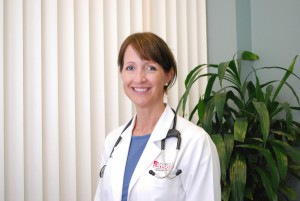
Health Matters for Teenagers by Alison Sims M.D.
 Every fall I have the pleasure of examining our bright young tweens and teens for their school sports physicals. It is always a joy to hear about their passion for sports, and see them growing taller and more mature each year. At the end of the History and Physical, and in the company of one of their parents, I like to discuss early detection of testicular cancer in boys and idiopathic scoliosis in girls while I have their undivided attention. It is a rare moment to have their complete focus to teach them important things about their growing bodies and to have their parent there to ask questions. I have had many parents thank me for bringing up these difficult discussions and for the education.
Every fall I have the pleasure of examining our bright young tweens and teens for their school sports physicals. It is always a joy to hear about their passion for sports, and see them growing taller and more mature each year. At the end of the History and Physical, and in the company of one of their parents, I like to discuss early detection of testicular cancer in boys and idiopathic scoliosis in girls while I have their undivided attention. It is a rare moment to have their complete focus to teach them important things about their growing bodies and to have their parent there to ask questions. I have had many parents thank me for bringing up these difficult discussions and for the education.
Teenage boys need to know about the most common cancer in American males between the ages of 15 and 34 which is testicular cancer. Just like breast cancer in women, it is highly treatable and curable if detected early. It can be a subtle discomfort, swelling, or lump inside the scrotum or on the testicle that can easily be ignored. If it is not treated in the early stage, it can spread to the liver, lungs, bones, and brain. It is more common in Caucasian men and young men although it can occur at any age. It is recommended by some experts that young men do a monthly self-exam after a warm shower when the scrotum is relaxed to find anything unusual or different. The self-exam is done with the index and middle fingers underneath pressing with the thumb on top to feel the spermatic cord attached in the back, and the smooth oval-shaped testicle. It is normal to have one testicle larger than the other. If your teen finds something he is worried about it should be further evaluated right away by a simple ultrasound. This is a painless exam done with sound waves, and again, early detection is the best medicine.
Prepubescent and teenage girls need to know about scoliosis, or curvature of the spine, as it is over 10 times more common in girls than in boys (ratio of 11:1), and scoliosis in a girl has a higher risk of progressing without treatment. Most cases of scoliosis are mild, but if the spine curves too much it can reduce the space for the heart and lungs making it difficult to breathe and causing heart damage. Unchecked advanced scoliosis can also lead to lifelong constant back pain. The most common type of scoliosis is called Adolescent Idiopathic Scoliosis (AIS) and idiopathic means that the cause is unknown. The curvature is known to begin just before menses in girls around age 9, and a few years later for boys, and must be evaluated early and treated before the spine stops growing, which is usually 2 years post-menarche in girls. At first the curve can be subtle and easily ignored. Signs and symptoms may include: uneven shoulders, one shoulder blade that is more prominent, uneven waist shape, or one hip higher than the other. If your tween or teen is identified during a school physical to have scoliosis then it is recommended that they be evaluated further by an orthopedic specialist. The specialist will determine if treatment with a brace is warranted to prevent further curvature.
It is important to note that health discussions are not easy for tweens and teens. They are already very self-conscious about their appearance as their bodies are rapidly changing. It is also an emotional and socially challenging stage of life. Be sure to talk to your children regularly about their bodily concerns, and then bring them for further evaluation to your doctor. Early detection and timely treatment is important at any age.
The information provided is for general interest only and should not be misconstrued as a diagnosis, prognosis or treatment recommendation. This information does not in any way constitute the practice of medicine, or any other health care profession. Readers are directed to consult their health care provider regarding their specific health situation. Marque Medical is not liable for any action taken by a reader based upon this information.
